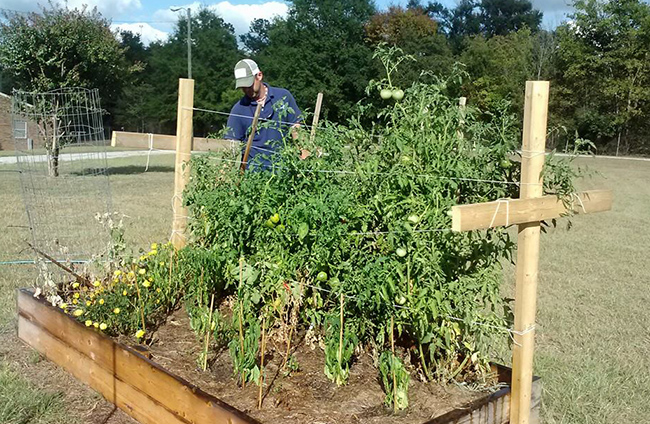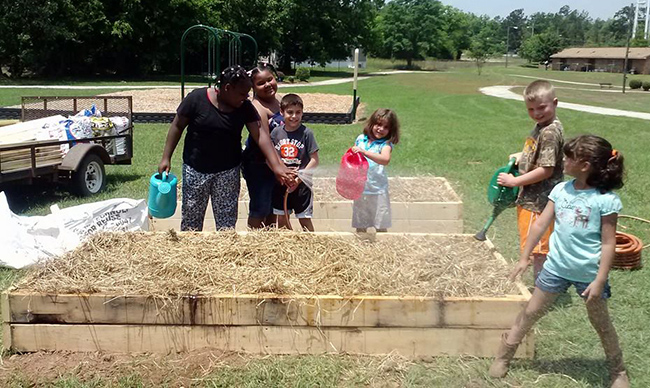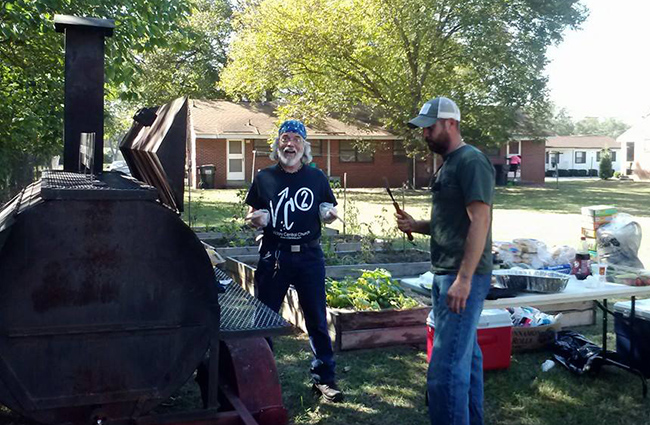Mary, Mary, How Does Your Community Garden Grow?
Print This PostHow one resident’s green thumb helps others eat healthier

by Diana St. Lifer
Mary Thomas grew up eating a variety of foods from the Earth, reaping the healthy benefits of meals that incorporate fresh fruits and vegetables.
So when the 74-year-old Washington County resident was presented with the opportunity last year to adopt the community garden at her housing development, she gave the green thumbs up.
“I was brought up on garden food,” said Thomas, who has lived at the Tennille Housing Authority development for 17 years. “We ate tomatoes, cucumbers, peppers, squash, zucchini, collards, cabbage—anything you can grow in a garden.”
When the Washington County Family Connection and Communities in Schools built a community garden at the housing authority, Thomas was the first resident to get involved and help nurture the garden beds. She officially adopted the garden last year, and is diligent in caring for it so others also can enjoy the benefits gathering and eating natural foods from the harvest.

Good nutrition has always been a part of Thomas’s life. When her late husband, Matthew, developed diabetes shortly after they married in 1958, she knew diet would play an essential role in managing the disease that affects nearly 30 million Americans.
“I knew I had to cook healthy for him,” said Thomas. And she was right. According to the American Diabetes Association, eating well to maintain a healthy weight is one of the most important things people can do to lower their risk for type 2 diabetes and heart disease.
Although her husband passed away eight years ago, Thomas continues to encourage others to adopt a healthy lifestyle. With 11 children, 17 grandchildren and eight great-grandchildren, Thomas is influencing new generations to eat smart.
“My grandchildren like to eat healthy because they see what I eat—salad, cabbage, oatmeal, and collard greens,” she said. “They know there will be healthy snacks when they visit me.”
When 5-year-old Mirichel visits her “ma ma poo” she knows they’ll be spending time in the community garden. “She loves the garden,” Thomas said. “We clean it up and weed out the grass. And when the neighbors’ children see us there, they come out to help, too.”

Rhonda Harmon, a former Family Connection board member, said children were “amazingly receptive” to the gardens, helping to build the beds and learning about the growing process. They also enjoyed trying new vegetables.
Later in the summer, all the housing residents had an opportunity to feast on what had been grown in the garden during a community cookout.
“We grilled zucchini, squash, and tomatoes with chicken to give them an idea of how they can cook a bit healthier,” said Roy Jackson, executive director of Washington County Family Connection and Communities in Schools.

Thomas also has the community practicing portion control. “They tell others I got them eating on small plates,” she said, laughing. “There’s no need to pile up the food.”
Also a role model for the benefits of staying active, Thomas walks two miles several days a week, despite having had knee and hip surgeries. With a daily diet of fruits and vegetables, regular exercise, and drinking plenty of water—no sweet tea for this southern belle—it’s easy to see how Thomas is helping to grow not just a garden, but also a community of healthy residents.
Diana St. Lifer is a professional writer with more than 25 years’ experience. She holds a bachelor’s degree in communications, a post-B.A. certificate in child advocacy, and is a certified professional life coach who specializes in teen and adolescent issues.
The message to the more than 20,000 residents of Washington County is loud and clear: Shape Up! And Washington County Family Connection and Communities in Schools is ready to do what it takes to help residents in the 680-square-mile county improve their lives through healthy choices.
Read “Washington County Helping Its Residents Shape Up.”
Low birthweight, childhood obesity, and a literacy gap are serious threats to the well-being of Georgia’s families and children. Recognizing the impact these pressing issues have on the state’s health, safety, and ability to prosper, Georgia Family Connection Partnership has launched three initiatives dedicated to developing and implementing strategies that address these key indicators.
Read “Eleven Family Connection Collaboratives Team Up to Tackle Key Indicators of Child and Family Well-Being.”
